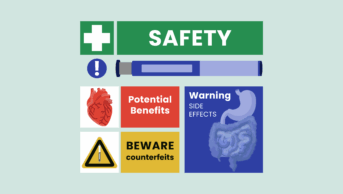Parenteral nutrition (PN) is a high-cost, high-risk therapy, essential for patients with intestinal failure or critical malabsorption, yet it presents logistical and clinical challenges, particularly regarding appropriate use and safe delivery. Inappropriate PN prescribing can increase the risk of metabolic complications, infection and unwarranted costs. As recommended by the British Association for Parenteral and Enteral Nutrition (BAPEN), best practice requires coordinated multidisciplinary team (MDT) input and careful stewardship of resources to ensure safe and effective delivery of PN therapy1. At Royal Derby Hospital, a pharmacy-led service improvement project delivered in collaboration with the nutrition MDT has achieved major gains in sustainability, cost reduction and clinical governance. This was accomplished through three areas: digitalisation of patient records; optimisation of PN stock management; and improvement of training and educational resources.
At Royal Derby Hospital, the nutrition team identified inefficiencies in how PN was prescribed, documented and supplied. Historically, PN documentation was entirely paper-based and decentralised, with consultants, nurses, dietitians and pharmacists maintaining separate records. This resulted in fragmented care, duplication of effort and increased risk of error. In addition, suboptimal stock control of pre-supplement PN infusions led to unnecessary bespoke PN orders from external suppliers, inflating costs and contributing to avoidable waste.
To address these issues, the team implemented a tripartite quality improvement initiative:
- A transition to a digital electronic patient record (EPR) for daily PN review and medical documentation;
- An overhaul of PN stock management processes, protocols and guidelines, steered by quarterly multidisciplinary reviews;
- A comprehensive revision of all educational resources related to PN, supported by the implementation of a clinical standard operating procedure (SOP) safeguarding clinically appropriate and cost-effective practises.
These interventions were driven by pharmacy, reflecting the broader shift in NHS priorities towards greener, digitally-enabled healthcare systems2.
Digitalising the parenteral nutrition pathway
In August 2023, a bespoke PN monitoring spreadsheet was developed by the pharmacist, standardising documentation across all four disciplines within the nutrition MDT, with formula to enable automatic calculation of nutritional requirements based on patient height, weight, sex, activity factor and clinical status. It was made accessible to all members of the MDT during daily PN ward round, providing live updates to those given access (as on NHS SharePoint).
The monitoring spreadsheet also included:
- ‘Daily fluid balance calculators’, incorporating all IV, enteral and oral inputs against outputs from all sites;
- ‘Complex fluid balance calculator’, calculating Na+/K+/ Cl– inputs and outputs from various medications, intravenous fluids or output sites, as per the NICE diagram of losses3;
- Sodium load estimators (mmol), accounting for sodium in IV fluids, medications and diluents;
- Pre-filled nutrient data for stocked pre-supplemented PN bags, aiding real-time clinical decision-making and prescribing;
- Updated nutritional requirement calculator, to help aid dietician clinical judgement in choosing PN regimes that best match calculated nutritional requirements.
The tool demonstrated considerable value in streamlining multidisciplinary input and clinical documentation, prompting its further development and full integration into the hospital’s ePrescribing and Medicines Administration (ePMA) system, Lorenzo, as a dedicated electronic patient record (EPR) for PN. It further safeguarded manual calculations, standardised record-keeping and improved accuracy in prescribing decisions.
This transition has streamlined clinical handovers, reduced the risk of documentation loss and enabled safer, more consistent decision-making across disciplines
Between January and July 2023, PN documentation required an average of eight paper sheets per patient, totalling over 300 sheets for 20 patients. Following implementation of the PN monitoring spreadsheet, paper use fell by 63% during a four-month transition period. By January 2024, PN documentation was fully digital.
This transition has streamlined clinical handovers, reduced the risk of documentation loss and enabled safer, more consistent decision-making across disciplines4. It also aligns with NHS Digital’s long-term goal of fully paperless patient records and demonstrates how pharmacists can lead meaningful digital transformation5.
Optimising stock and reducing waste
A second intervention targeted PN stock governance. Previously, the Central Aseptic Services Unit (CASU) held no defined minimum stock levels for pre-supplemented PN bags, increasing reliance on bespoke orders from external providers. These bespoke bags, while necessary in some cases, are significantly more expensive and less sustainable owing to custom compounding and transportation requirements.
To improve this, the pharmacy team introduced quarterly PN stock review meetings with the nutritional MDT. Chaired by pharmacists and the chief pharmacy technician, this meeting would review PN usage trends and upcoming clinical demands, enabling proactive stock level planning. Wastage reports were also assessed to help monitor stock levels that persisted higher than current usages levels.
Additionally, a pharmacist-dietitian authored clinical standard operating procedure (SOP) was introduced, defining when bespoke PN was clinically appropriate versus when pre-supplemented stock should be used. This improved consistency and helped junior prescribers make more cost-effective decisions.
Impact of interventions on ITH Pharma use and expenditure
These interventions led to measurable improvements. ITH Pharma expenditure fell by £13,142.04, while wastage costs for pre-supplemented PN halved, from £10,723 to £5,449. Stock-out related orders dropped dramatically, from 78 orders to just 4 orders (representing a 94.9% decrease) between July 2024 and February 2025, and bespoke PN spend was reduced by 35%, from £37,402 to £24,260.
Reduction in ITH Pharma orders:
- Before stock review (June 2023 – June 2024); 289 total ITH orders, 78 for stock-outs (26.99%);
- After stock review (July 2024 – February 2025); 231 total ITH orders, only 4 for stock-outs (1.73%).
Financial impact:
- Pre-review ITH costs: £37,402;
- Post review ITH costs: £24,260;
- Total savings: £13,142.
These outcomes reflect both improved stock management and a significant reduction in unnecessary bespoke PN usage, supporting both cost-efficiency and sustainability. Ongoing data collection continues to showcase major financial gains in both usage and sustainability.
Environmental impact and greener practice
Environmental sustainability is increasingly a focus of NHS improvement efforts. The PN project at Royal Derby demonstrated how digitalisation and improved stock control can directly reduce the carbon footprint of pharmacy-led services.
By eliminating paper records (an estimated 500–800 sheets annually) and reducing reliance on externally manufactured bespoke PN, the team achieved tangible environmental benefits. Fewer bespoke orders reduced packaging waste, delivery mileage and compounding resource use.
This aligns with the NHS Greener Plan, which highlights the pharmacy workforce’s unique opportunity to reduce the environmental impact of medicines use and supply6. As digital systems mature, pharmacist-led innovations will be critical in ensuring that clinical care and environmental stewardship are not mutually exclusive.
Conclusion
Pharmacists and pharmacy technicians were pivotal in designing, implementing and sustaining these improvements. By leveraging their understanding of clinical workflows, medicines governance and digital systems, both professions ensured that changes were both clinically safe and operationally viable.
The success of this project reflects how pharmacy professionals can drive system-wide improvement beyond traditional dispensary roles. The model established at Royal Derby is scalable to other acute trusts, particularly those still reliant on paper-based documentation or experiencing waste from bespoke PN orders.
By integrating PN documentation into the hospital’s ePMA and standardising stock reviews, the nutrition team at Royal Derby Hospital achieved substantial cost savings, eliminated paper records and enhanced clinical governance.
As the NHS continues to digitise and decarbonise, the role of pharmacists and pharmacy technicians in leading such initiatives will become increasingly vital. The Royal Derby model provides a replicable framework for delivering safer, greener, and more cost-effective PN services.
Joshua Dhamrait, advanced pharmacist — critical care and theatres, Royal Derby Hospital, University Hospitals of Derby and Burton NHS Foundation Trust;
Jack Brearley, chief pharmacy technician — central aseptic services unit, Royal Derby Hospital, University Hospitals of Derby and Burton NHS Foundation Trust.
- 1.Parenteral nutrition. British Association for Parenteral and Enteral Nutrition. Accessed July 2025. https://www.bapen.org.uk/nutrition-support/parenteral-nutrition
- 2.Delivering a Net Zero NHS. NHS England. October 2020. Accessed July 2025. https://www.england.nhs.uk/greenernhs/publication/delivering-a-net-zero-national-health-service
- 3.Diagram of ongoing losses. National Institute for Health and Care Excellence. December 2013. Accessed July 2025. https://www.nice.org.uk/guidance/cg174/resources/diagram-of-ongoing-losses-191664109
- 4.Nutrition support for adults: oral nutrition support, enteral tube feeding and parenteral nutrition [CG32]. National Institute for Health and Care Excellence . 2006. Accessed July 2025. https://www.nice.org.uk/guidance/cg32
- 5.The Future of Healthcare: Our Vision for Digital, Data and Technology in Health and Care. NHS Digital. 2018. Accessed July 2025. https://www.gov.uk/government/publications/the-future-of-healthcare-our-vision-for-digital-data-and-technology-in-health-and-care/the-future-of-healthcare-our-vision-for-digital-data-and-technology-in-health-and-care
- 6.Pharmacy is uniquely placed to tackle climate change. Pharmaceutical Journal. Published online 2024. doi:10.1211/pj.2024.1.311303


